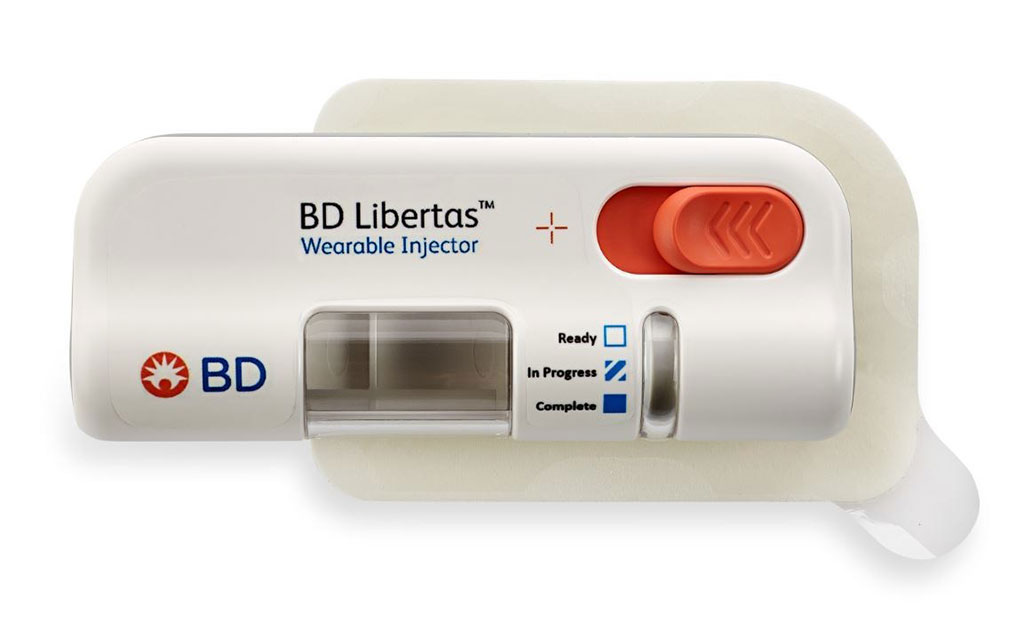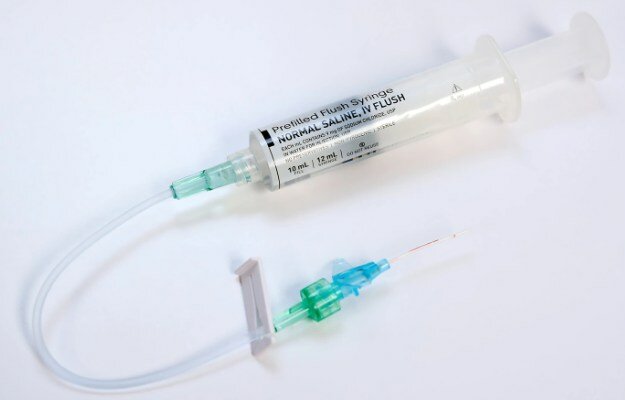Wearable Injector Delivers Drugs Subcutaneously
|
By HospiMedica International staff writers Posted on 31 Dec 2020 |

Image: The BD Libertas Wearable Injector (Photo courtesy of BD)
A novel adhesive subcutaneous injector delivers large volume drugs to support life cycle management of biological therapies.
The BD (Franklin Lakes, NJ, USA) BD Libertas Wearable Injector is a drug delivery system, currently in final phases of development, designed to deliver drugs with viscosities up to 50 cP in 2-5 mL and 5-10 mL configurations, facilitating the migration from intravenous (IV) to subcutaneous routes of administration. The device delivers therapeutic drugs using a customizable flow rate adjusted to drug viscosity and therapy needs, providing slow drug infusion subcutaneously over the desired period of time, ranging from a few seconds to several minutes. Optional smart functionality enables connectivity to the healthcare network.
A recent clinical trial to evaluate the performance of the 5 mL BD Libertas device in humans, which monitored effects such as tissue responses, skin reactivity, and patient acceptance, confirmed that the device delivered within an acceptable time period 5 mL of 8 cP subcutaneous injections to the abdomen and thigh, regardless of subject age, gender, or body mass index (BMI), and both with or without patient movement. No severe wheal, erythema, or bleeding was observed, and no unacceptable pain was noted at 24 hours post-injection.
“These results show that BD Libertas Wearable Injector effectively delivers dose volumes up to 5 mL subcutaneously, and may be leveraged by our pharmaceutical partners as a reliable platform for large volume delivery,” said Eric Borin, worldwide president of BD Pharmaceutical Systems. “BD is committed to working with our customers and the broader pharmaceutical market to meet their needs by enabling an expanded drug delivery design space.”
Subcutaneous injections are highly effective in administering medications such as insulin, morphine, diacetylmorphine, and goserelin. As subcutaneous tissue has few blood vessels, the drugs are injected as a bolus, undergoing subsequent slow, sustained rates of absorption. It is a slower (but less painful) route than intramuscular injections, especially for viscous drugs, but still faster than intradermal injections.
Related Links:
BD
The BD (Franklin Lakes, NJ, USA) BD Libertas Wearable Injector is a drug delivery system, currently in final phases of development, designed to deliver drugs with viscosities up to 50 cP in 2-5 mL and 5-10 mL configurations, facilitating the migration from intravenous (IV) to subcutaneous routes of administration. The device delivers therapeutic drugs using a customizable flow rate adjusted to drug viscosity and therapy needs, providing slow drug infusion subcutaneously over the desired period of time, ranging from a few seconds to several minutes. Optional smart functionality enables connectivity to the healthcare network.
A recent clinical trial to evaluate the performance of the 5 mL BD Libertas device in humans, which monitored effects such as tissue responses, skin reactivity, and patient acceptance, confirmed that the device delivered within an acceptable time period 5 mL of 8 cP subcutaneous injections to the abdomen and thigh, regardless of subject age, gender, or body mass index (BMI), and both with or without patient movement. No severe wheal, erythema, or bleeding was observed, and no unacceptable pain was noted at 24 hours post-injection.
“These results show that BD Libertas Wearable Injector effectively delivers dose volumes up to 5 mL subcutaneously, and may be leveraged by our pharmaceutical partners as a reliable platform for large volume delivery,” said Eric Borin, worldwide president of BD Pharmaceutical Systems. “BD is committed to working with our customers and the broader pharmaceutical market to meet their needs by enabling an expanded drug delivery design space.”
Subcutaneous injections are highly effective in administering medications such as insulin, morphine, diacetylmorphine, and goserelin. As subcutaneous tissue has few blood vessels, the drugs are injected as a bolus, undergoing subsequent slow, sustained rates of absorption. It is a slower (but less painful) route than intramuscular injections, especially for viscous drugs, but still faster than intradermal injections.
Related Links:
BD
Latest Patient Care News
- Revolutionary Automatic IV-Line Flushing Device to Enhance Infusion Care
- VR Training Tool Combats Contamination of Portable Medical Equipment
- Portable Biosensor Platform to Reduce Hospital-Acquired Infections
- First-Of-Its-Kind Portable Germicidal Light Technology Disinfects High-Touch Clinical Surfaces in Seconds
- Surgical Capacity Optimization Solution Helps Hospitals Boost OR Utilization

- Game-Changing Innovation in Surgical Instrument Sterilization Significantly Improves OR Throughput
- Next Gen ICU Bed to Help Address Complex Critical Care Needs
- Groundbreaking AI-Powered UV-C Disinfection Technology Redefines Infection Control Landscape
- Clean Hospitals Can Reduce Antibiotic Resistance, Save Lives
- Smart Hospital Beds Improve Accuracy of Medical Diagnosis
- New Fast Endoscope Drying System Improves Productivity and Traceability
- World’s First Automated Endoscope Cleaner Fights Antimicrobial Resistance
- Portable High-Capacity Digital Stretcher Scales Provide Precision Weighing for Patients in ER
- Portable Clinical Scale with Remote Indicator Allows for Flexible Patient Weighing Use
- Innovative and Highly Customizable Medical Carts Offer Unlimited Configuration Possibilities
- Biomolecular Wound Healing Film Adheres to Sensitive Tissue and Releases Active Ingredients
Channels
Critical Care
view channel
Light-Based Technology to Measure Brain Blood Flow Could Diagnose Stroke and TBI
Monitoring blood flow in the brain is crucial for diagnosing and treating neurological conditions such as stroke, traumatic brain injury (TBI), and vascular dementia. However, current imaging methods like... Read more
AI Heart Attack Risk Assessment Tool Outperforms Existing Methods
For decades, doctors have relied on standardized scoring systems to assess patients with the most common type of heart attack—non-ST-elevation acute coronary syndrome (NSTE-ACS). The GRACE score, used... Read moreSurgical Techniques
view channel
Minimally Invasive Endoscopic Surgery Improves Severe Stroke Outcomes
Intracerebral hemorrhage, a type of stroke caused by bleeding deep within the brain, remains one of the most challenging neurological emergencies to treat. Accounting for about 15% of all strokes, it carries... Read more
Novel Glue Prevents Complications After Breast Cancer Surgery
Seroma and prolonged lymphorrhea are among the most common complications following axillary lymphadenectomy in breast cancer patients. These postoperative issues can delay recovery and postpone the start... Read moreHealth IT
view channel
Printable Molecule-Selective Nanoparticles Enable Mass Production of Wearable Biosensors
The future of medicine is likely to focus on the personalization of healthcare—understanding exactly what an individual requires and delivering the appropriate combination of nutrients, metabolites, and... Read moreBusiness
view channel
Philips and Masimo Partner to Advance Patient Monitoring Measurement Technologies
Royal Philips (Amsterdam, Netherlands) and Masimo (Irvine, California, USA) have renewed their multi-year strategic collaboration, combining Philips’ expertise in patient monitoring with Masimo’s noninvasive... Read more
B. Braun Acquires Digital Microsurgery Company True Digital Surgery
The high-end microsurgery market in neurosurgery, spine, and ENT is undergoing a significant transformation. Traditional analog microscopes are giving way to digital exoscopes, which provide improved visualization,... Read more
CMEF 2025 to Promote Holistic and High-Quality Development of Medical and Health Industry
The 92nd China International Medical Equipment Fair (CMEF 2025) Autumn Exhibition is scheduled to be held from September 26 to 29 at the China Import and Export Fair Complex (Canton Fair Complex) in Guangzhou.... Read more
















